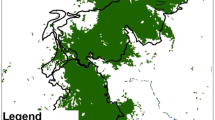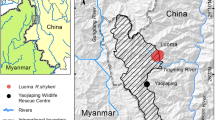Abstract
The predation of army ants (Eciton rapax) was recorded during an observational study of the feeding behavior of a group of titi monkeys (Plecturocebus toppini) in an urban fragment of forest in Acre, Brazil. During one observed event, the group’s adult female used its tail to retrieve ants, a type of behavior not observed previously in this genus. All incidents of on-forest floor foraging occurred during the dry season, when fruit was least abundant in the forest, while on other occasions, the ants were captured from tree branches and leaves. The observation of predation and ground-level foraging recorded in this study reinforce the adaptive capacity of P. toppini for survival in fragmented forests, and this was also the first record of the predation of army ants by this titi species.


Similar content being viewed by others
References
Altmann J (1974) Observational study of behavior: sampling methods. Behaviour 49:227–266
Barnett AA, Bowler M, Bezerra BM, Defler TR (2013) Ecology and behaviour of uakaris (genus Cacajao). In: Veiga LM, Barnett AA, Ferrari SF, Norconk MA (eds) Evolutionary biology and conservation of titis, sakis and uacaris. Cambridge University Press, Cambridge, pp 151–172
Barnett AA, Ronchi-Teles B, Silva WS, Andrade R, Almeida T, Bezerra BM et al (2017) Covert carnivory? A seed-predating primate, the golden-backed uakari, shows preferences for insect-infested fruits. J Zool Res 1:16–31
Bennett CL, Leonard S, Carter S (2001) Abundance, diversity, and patterns of distribution of primates on the Tapiche River in Amazonian Peru. Am J Primatol 54:119–126
Boinski S, Timm RM (1985) Predation by squirrel monkeys and double-toothed kites on tent-making bats. Am J Primatol 9:121–127
Boyle SA (2016) Pitheciids in fragmented habitats: land cover change and its implications for conservation. Am J Primatol 78:534–549
Boyle SA, Thompson CL, DeLuycker A et al (2016) Geographic comparison of plant genera used in frugivory among the pitheciids Cacajao, Callicebus, Chiropotes, and Pithecia. Am J Primatol 78:493–506
Brockman DK, Van Schaik CP (2005) Seasonality and reproductive function. In: Brockman DK, van Schaik CP (eds) Seasonality in primates: studies of living and extinct human and non-human primates. Cambridge University Press, Cambridge, pp 269–305
Carrillo-Bilbao G, Di Fiore A, Fernandez-Duque E (2005) Dieta, forrajeo y presupuesto de tiempo em cotoncillos (Callicebus discolor) del Parque Nacional Yasuní en la Amazonia Ecuatoriana. Neotrop Primates 13:7–11
Caselli CB, Setz EZF (2011) Feeding ecology and activity pattern of black-fronted titi monkeys (Callicebus nigrifrons) in a semideciduous tropical forest of southern Brazil. Primates 52:351–359
Chesser RT (1995) Comparative diets of obligate ant-following birds at a site in northern Bolivia. Biotropica 1:382–390
Chivers DJ, Hladik CM (1980) Morphology of the gastrointestinal tract in primates. J Morphol 166:337–386
Coates-Estrada R, Estrada A (1989) Avian attendance and foraging at army-ant swarms in the tropical rain forest of Los Tuxtlas, Veracruz, Mexico. J Trop Ecol 5:281–292
DeLuycker AM (2012) Insect prey foraging strategies in Callicebus oenanthe in northern Peru. Am J Primatol 74:450–461
Di Fiore A (2004) Diet and feeding ecology of woolly monkeys in a western Amazonian rain forest. Int J Primatol 25:767–801
dos Santos GP, Galvão C, Young RJ (2012) The diet of wild black-fronted titi monkeys Callicebus nigrifrons during a bamboo masting year. Primates 53:265–272
Duarte AF (2005) Variabilidade e tendência das chuvas em Rio Branco, Acre, Brasil. Rev Bras Meteorol 20:37–42
Duarte AF (2006) Aspectos da climatologia do Acre, Brasil, com base no intervalo 1971–2000. Rev Bras Meteorol 21:308–317
Ferrari SF (1991) An observation of western black spider monkeys, utilising an arboreal water source. Biotropica 23:307–308
Garber PA (1987) Foraging strategies among living primates. Ann Rev Anthropol 16:339–364
Gibson L, Koenig A (2012) Neighboring groups and habitat edges modulate range use in Phayre’s leaf monkeys (Trachypithecus phayrei crepusculus). Behav Ecol Sociobiol 66:633–643
Gudger EW (1946) Does the jaguar use his tail as a lure in fishing. J Mamm 27:37–49
Guilherme (2001) Comunidade de aves do campo e Parque Zoobotânico da Universidade Federal do Acre, Brasil. Tangara 1:57–73
Guilherme E (2016) Aves do Acre. Edufac, Rio Branco. http://sistemas.ufac.br/editora/aves_do_acre.pdf. Accessed 27 June 2018
Harper LH (1989) The persistence of ant-following birds in small Amazonian forest fragments. Acta Amazonica 19:249–263
Heiduck S (2002) The use of disturbed and undisturbed forest by masked titi monkeys Callicebus personatus melanochir is proportional to food availability. Oryx 36:133–139
Hemingway CA, Bynum N (2005) The influence of seasonality on primate diet and ranging. In: Brockman DK, van Schaik CP (eds) Seasonality in primates: studies of living and extinct human and non-human primates. Cambridge University Press, Cambridge, pp 57–104
Heymann EW, Nadjafzadeh MN (2013) Insectivory and prey foraging techniques in Callicebus—a case study of Callicebus cupreus and comparison to other pitheciids. In: Veiga LM, Barnett AA, Ferrari SF, Norconk MA (eds) Evolutionary biology and conservation of titis, sakis and uakaris. Cambridge University Press, Cambridge, pp 215–224
Heymann EW, Knogge C, Herrera ER (2000) Vertebrate predation by sympatric tamarins, Saguinus mystax and Saguinus fuscicollis. Am J Primatol 51:153–158
Kay RF (2015) Biogeography in deep time—What do phylogenetics, geology, and paleoclimate tell us about early platyrrhine evolution? Mol Phylogenet Evol 82:358–374
Koops K, Schöning C, McGrew WC, Matsuzawa T (2015) Chimpanzees prey on army ants at Seringbara, Nimba Mountains, Guinea: predation patterns and tool use characteristics. Am J Primatol 77:319–329
Lambert J (1998) Primate digestion: interactions among anatomy, physiology, and feeding ecology. Evol Anthropol 7:8–20
MacArthur RH, Pianka ER (1966) On optimal use of a patchy environment. Am Nat 100:603–609
Mallott EK, Malhi RS, Garber PA (2015) High-throughput sequencing of fecal DNA to identify insects consumed by wild Weddell’s saddleback tamarins (Saguinus weddelli, Cebidae, Primates) in Bolivia. Am J Phys Anthropol 156:474–481
Marsh C, Link A, King-Bailey G, Donati G (2016) Effects of fragment and vegetation structure on the population abundance of Ateles hybridus, Alouatta seniculus and Cebus albifrons in Magdalena Valley, Colombia. Folia Primatol 87:17–30
Meneses Filho LC, Ferraz PA, Pinha LA, Brilhante NA (1995) Comportamento de 24 espécies arbóreas tropicais madeireiras introduzidas no Parque Zoobotânico. Edufac, Rio Branco
Michalski F, Peres CA (2007) Disturbance-mediated mammal persistence and abundance-area relationships in Amazonian forest fragments. Conserv Biol 21:1626–1640
Milano MZ, Monteiro-Filho EL (2009) Predation on small mammals by capuchin monkeys, Cebus cay. Neotrop Primates 16:78–80
Milton K (1981) Distribution patterns of tropical plant foods as an evolutionary stimulus to primate mental development. Am Anthropol 83:534–548
Nadjafzadeh MN, Heymann EW (2008) Prey foraging of red titi monkeys, Callicebus cupreus, in comparison to sympatric tamarins, Saguinus mystax and Saguinus fuscicollis. Am J Phys Anthropol 135:56–63
Nagy-Reis MB, Setz EZ (2017) Foraging strategies of black-fronted titi monkeys (Callicebus nigrifrons) in relation to food availability in a seasonal tropical forest. Primates 58:149–158
Norconk MA (2007) Sakis, uakaris, and titi monkeys: behavioral diversity in a radiation of primate seed predators. In: Campbell CJ, Fuentes A, MacKinnon KC, Bearder SK, Stumpf RM (eds) Primates in perspective. Oxford University Press, New York, pp 123–135
Norconk MA, Wrigth BW, Conklin-Brittan NL, Vinyard CJ (2009) Mechanical and nutritional properties of food as factors in Platyrrine dietary adaptations. In: Garber P, Estrada A, Bicca-Marques JC, Heymann E, Strier K (eds) South American primates—comparative perspectives in the study of behavior, ecology and conservation. Springer, New York, pp 279–319
O’Donnell S, Lattke J, Powell S, Kaspari M (2009) Species and site differences in neotropical army ant emigration behaviour. Ecol Entomol 34:476–482
Palacios E, Rodriguez A, Defler TR (1997) Diet of a group of Callicebus torquatus lugens (Humboldt, 1812) during the annual resource bottleneck in Amazonian Colombia. Int J Primatol 18:503–522
Partridge LW, Britton NF, Franks NR (1996) Army ant population dynamics: the effects of habitat quality and reserve size on population size and time to extinction. Proc R Soc Lond B 263:735–741
Pinacho-Guendulain B, Ramos-Fernández G (2017) Influence of fruit availability on the fission–fusion dynamics of spider monkeys (Ateles geoffroyi). Int J Primatol 38:466–484
Rettenmeyer CW (1963) Behavioral studies of army ants. Estudios de comportamiento de hormigas guerreras. Universit Kansas Scienc Bullet 44:281–465
Roberts DL, Cooper L, Petit J (2000) Flock characteristics of ant-following birds in premontane moist forest and coffee agroecosystems. Ecol Appl 10:1414–1425
Rosenberger AL (1992) Evolution of feeding niches in new world monkeys. Am J Phys Anthropol 88:525–562
Rylands AB, Da Cruz M, Ferrari SF (1989) An association between marmosets and army ants in Brazil. J Trop Ecol 5:113–116
Schneirla TC (1933) Studies on army ants in Panama. J Comp Psychol 15:267–299
Schneirla TC (1934) Raiding and other outstanding phenomena in the behavior of army ants. Proc Natl Acad Scienc 20:316–321
Silva IO, Alvarenga AB, Boere V (2008) Occasional field observations of the predation on mice, dove and ants by black-tufted-ear marmosets (Callithrix penicillata). Neotrop Primates 15:59–62
Silveira M (2005) A floresta aberta com bambu no sudoeste da Amazônia: padrões e processos em múltiplas escalas. Edufac, Rio Branco
Sugiyama Y (1995) Tool-use for catching ants by chimpanzees at Bossou and Monts Nimba, West Africa. Primates 36:193–205
Terborgh J (1983) Five new world primates. Princeton University Press, Princeton
Torralvo K, Rabelo RM, Andrade A, Botero-Arias R (2017) Tool use by Amazonian capuchin monkeys during predation on caiman nests in a high-productivity forest. Primates 58:279–283
Vinhas L, Souza-Alves JP (2014) Bird predation by an endangered primate species, Callicebus Coimbrai, in the Brazilian Atlantic forest. Neotrop Primates 21:195–198
Wrangham RW, Riss EZ (1990) Rates of predation on mammals by Gombe chimpanzees, 1972–1975. Primates 31:157–170
Wright PC (1989) The nocturnal primate niche in the New World. J Hum Evol 18:635–658
Acknowledgements
We are grateful to the Coordination for Higher Education Training (CAPES: Coordenação de Aperfeiçoamento de Pessoal de Nível Superior) of the Brazilian government for providing a graduate stipend. We would also like to thank the team at the UFAC Insect Ecology Laboratory, in particular Prof. Fernando A. Schmidt and Andressa Menezes, for the identification of the ants, and Gerbson Maia for editing the photographs, Felipe Gonçalves by map and Prof. Stephen Ferrari for translation and comments.
Author information
Authors and Affiliations
Corresponding author
About this article
Cite this article
de Souza, F.S.C., Calouro, A.M. Predation of army ants by Toppin’s titi monkey, Plecturocebus toppini Thomas 1914 (Primates: Pitheciidae), in an urban forest fragment in eastern Acre, Brazil. Primates 59, 469–474 (2018). https://doi.org/10.1007/s10329-018-0677-4
Received:
Accepted:
Published:
Issue Date:
DOI: https://doi.org/10.1007/s10329-018-0677-4




